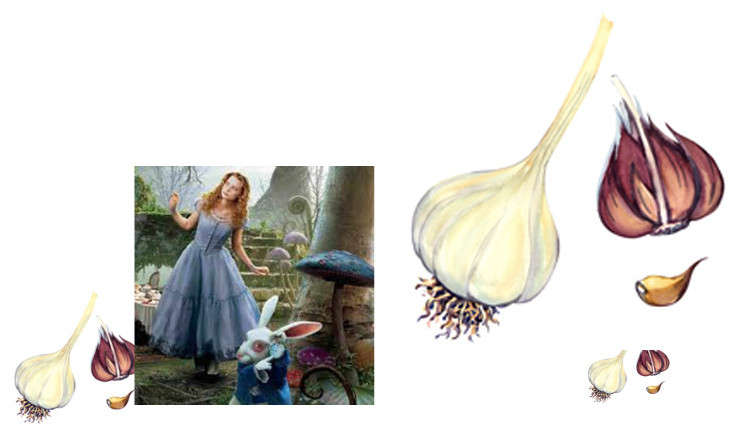Beyond pesto, pizza and bread: Garlic is medicine!
Think of it as allicin wonderland. Please forgive the pun – I didn’t make it up. Allicin is the principal active compound released in garlic that has inspired wonder in healers since ancient times. I say “released” because garlic does not actually contain allicin but rather the two ingredients needed to make it – a protein fragment alliin and an enzyme called allinase.
Garlic is one of the oldest cultivated plants. It has been used medicinally (and as a culinary ingredient) for thousands of years. Historical records as far back as 2600 BC show that it has been used to treat infections, lower blood pressure, fight cancer, protect against atherosclerosis, heart disease, asthma and allergies. These are just some of the recorded uses that medical science now validates in studies.
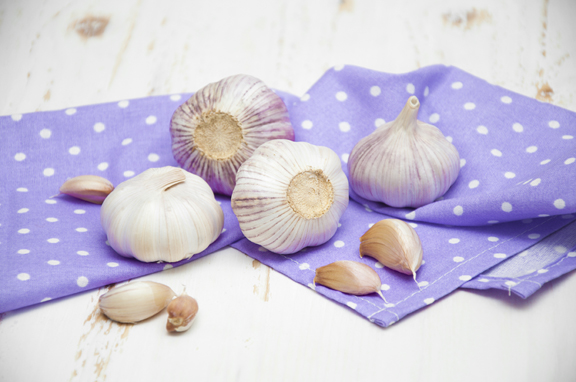
As you might have gleaned from my posts on eating weeds http://www.foodwisdomnutrition.com/eat-your-weeds-lambs-quarters/ as well as in my post on berries http://www.foodwisdomnutrition.com/tis-the-season-to-eat-berries-2/ eating closer to a food in its original form (i.e. not overly-bred for marketability, color, mild flavor, etc.) is usually nutritionally superior.
Garlic has this advantage: with a few exceptions, there has not been a lot of effort by plant breeders to change it, so even the ordinary garlic you purchase in the supermarket still packs some powerful health benefits.
Here’s a list from Dr. Alan Gaby’s compendium of nutritional research, Nutritional Medicine, of some of garlic’s health benefits and therapeutic uses that have been shown in studies:
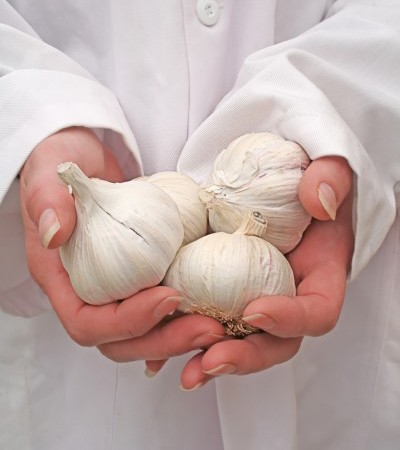
- Acquired immunodeficiency syndrome
- Atherosclerosis
- Candidiasis
- Common cold
- Corns
- Fibrinogen
- Heliobacter pylori
- Hypertension
- Infectious diseases
- Insect repellent
- Intermittent claudication
- Oxidative stress
- Platelet aggregation
- Serum cholesterol
- Triglycerides
- Warts
What you need to know: An important cooking tip, a fabulous peeling hack
and what to do about the breath problem
Garlic preparation
A huge factor in getting the maximum health benefits of eating garlic is in how you prepare your garlic.
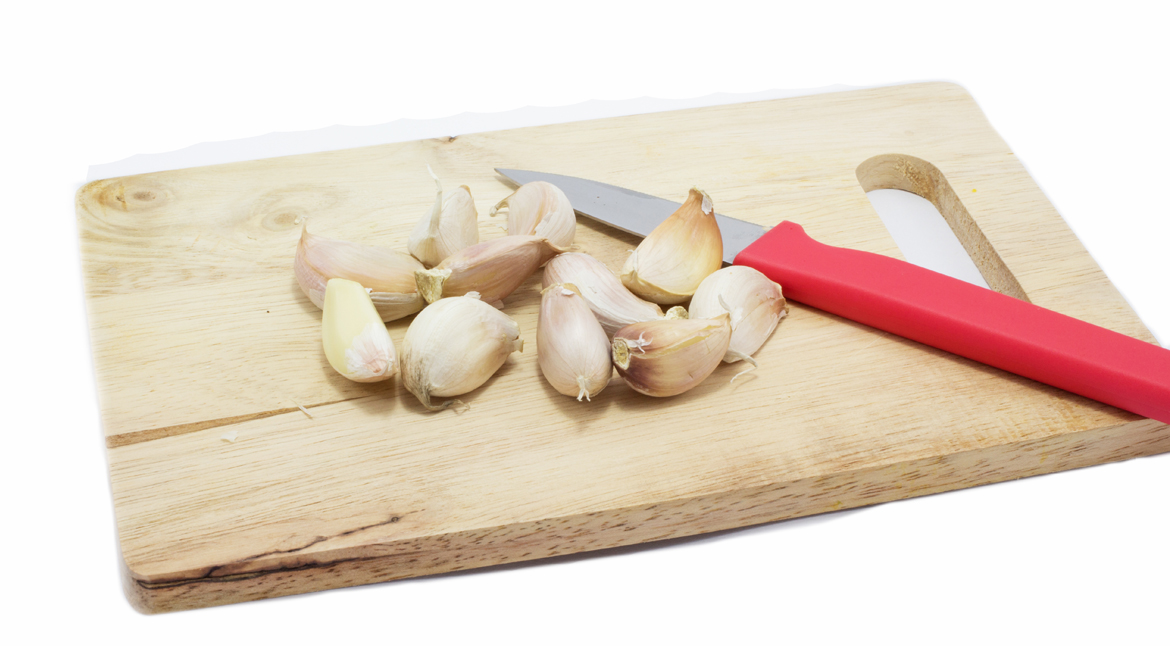
There are two components in garlic – a protein called alliin and an enzyme called alliinase – which have to combine in a chemical reaction in the presence of air before the powerful compound allicin is formed.
So here’s what you do in the kitchen:
If a recipe calls for garlic, after you mince, slice, crush or press it, let it sit out for at least 10 minutes before adding it to your stir fry, sauce or soup.
Since the enzymatic reaction is inhibited by heat, alliicin does not form in cooked dishes. If you are using it raw in pesto, salsas, bread, salad dressings, etc. you don’t have to worry about this step, of course. But not to worry if you are not always eating “press and rest” garlic, it contains numerous other compounds besides allicin that have important health effects.
The breath problem and some solutions
The problem is in those sulfur compounds which also provide th e powerful health effects. Actually it is the high content of selenium in these compounds that are eliminated through the lung and skin in the form of dimethyl selenide which are the odor-causing culprits. Remember to impress your dining companions with this fact at your next garlicky meal!
e powerful health effects. Actually it is the high content of selenium in these compounds that are eliminated through the lung and skin in the form of dimethyl selenide which are the odor-causing culprits. Remember to impress your dining companions with this fact at your next garlicky meal!
If you are hesitant to eat garlic because of the lingering odor here are some tips to help breakdown and neutralize those smelly sulphur compounds:
- Drink peppermint or green tea with and after a garlicky meal
- Eat some raw apple
- Eat garlic with greens (ie spinach and garlic).
- Suck on a wedge of lemon (if you can!)
- Chew on some parsley after the meal – there’s a reason for those little sprigs that garnish many restaurant dishes!
- Drink some milk
A (noisy) hack for peeling garlic cloves
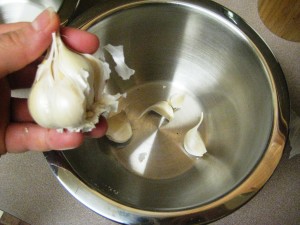
This is such an amazing trick to use when you want to save time spent peeling garlic cloves. Having lots of peeled cloves handy is an incentive to use more garlic. WARNING: this gets noisy!
Here’s the basic method:
- Separate the garlic heads into individual cloves and place in a medium size metal mixing bowl .
- Top with another metal bowl and shake vigorously for about 20 – 30 seconds, depending on the quantity and on your strength.
- Voila! You will have a bowl of peeled garlic cloves.
Here’s a YouTube link for visual learners:
https://www.youtube.com/watch?v=0d3oc24fD-c
Note: You can also do hack in a glass jar but in my experience the metal bowls are more efficient.
A recipe
And now that you have all those peeled garlic cloves (actually you could leave the skins on in the recipe below), make some broth to have on hand as an immune booster in the cold and flu season. It also makes a simple, elegant start to a meal especially if served immediately after preparing. It can be used for cooking rice, braising vegetables or adding to soups and stews.
Garlic broth freezes well also, as do peeled garlic cloves. The cloves lose their firmness after freezing but can still be chopped, minced or pressed to add to cooked dishes.
Garlic Broth
Cloves from 2 heads of garlic, peeled or with skins
2 quarts of water
A few sage leaves
1 bay leaf
1 sprig of thyme
A few parsley sprigs
Salt to taste
- Smash the peeled cloves with the side of a knife handle and let them rest for 10 minutes. (See above under “Garlic preparation” if you missed it.)
- Make a bouquet garni out of your herbs, or just add in the herbs on their own and strain them out later
- Bring the water to a gentle boil, add in the garlic cloves and herbs and simmer on low heat for about 1 hour.
- Strain (you could save the cloves and add them to dishes that require a mild garlic flavor) and add salt to taste.
References:
Bayan, L., Koulivand, P. H., & Gorji, A. (2014). Garlic: a review of potential therapeutic effects. Avicenna Journal of Phytomedicine, 4(1), 1–14.
Gorinstein, S., Leontowicz, H., Leontowicz, M., Jastrzebski, Z., Najman, K., Tashma, Z., … Trakhtenberg, S. (2010). The influence of raw and processed garlic and onions on plasma classical and non-classical atherosclerosis indices: investigations in vitro and in vivo. Phytotherapy Research: PTR, 24(5), 706–714. http://doi.org/10.1002/ptr.3001
Murray, M. T., Pizzorno, J. E., & Pizzorno, L. (2005). The encyclopedia of healing foods. New York: Atria Books.
Petrovska, B. B., & Cekovska, S. (2010). Extracts from the history and medical properties of garlic. Pharmacognosy Reviews, 4(7), 106–110. http://doi.org/10.4103/0973-7847.65321
Ried, K., Frank, O. R., Stocks, N. P., Fakler, P., & Sullivan, T. (2008). Effect of garlic on blood pressure: a systematic review and meta-analysis. BMC Cardiovascular Disorders, 8, 13. http://doi.org/10.1186/1471-2261-8-13
Robinson, J. (2013). Eating on the wild side: the missing link to optimum health (1. ed). New York, NY: Little, Brown and Co.

